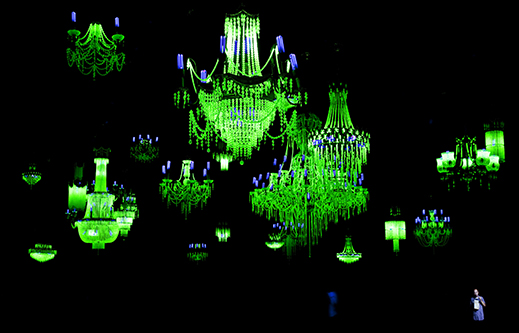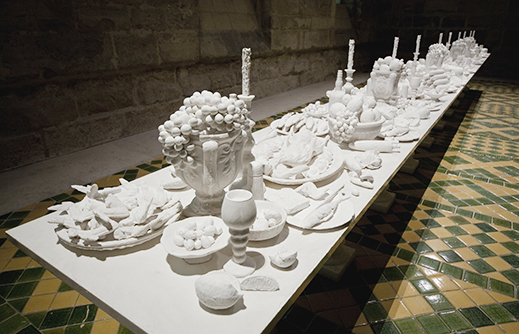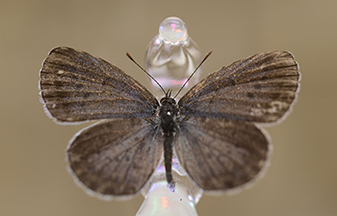 |
Focus features two in-depth reviews each month of fine art, architecture and design exhibitions and events at art museums, galleries and alternative spaces around Japan. The contributors are non-Japanese residents of Japan. |
|
|
 |
 |
 |
Swimming Against the Tide: Ken and Julia Yonetani
Lucy Birmingham |
 |
Sweet Barrier Reef (2009), sugar, icing sugar, polystyrene foam; 5 x 15 x 1.4 m. Photo by Ian Hobbs |
The beauty of art is its power to inspire -- to engage viewers with thought-provoking themes that can widen their worldview. Like Ai Weiwei, Jenny Holzer and Sebastien Preschoux, the conceptual art duo Ken and Julia Yonetani spark vigorous dialogue through sociopolitical content. Engaging and beautiful, their installations bravely take on issues threatening our natural environment.
The couple's exhibition The Emperor's New Clothes, opening at Tokyo's Mizuma Art Gallery on 22 February, focuses on our unstable global economy and its connection to the environment. "The market is really fragile these days. Too much debt and too much control by central banks and governments," says Ken, who once worked as a foreign exchange broker. "The real economy is not functioning so the central banks are trying to prop it up with all these policies. Quantitative easing in Japan. Negative interest rates. We're looking at how this will affect future resources." Julia adds, "In that way, for us, it connects with the environment. That we're living on borrowed time. Using the future. The works in the show -- all new -- are connected to the idea of money."
 |
|
Ultrabuddha: that is why I want to be saved (#5) (2010), type-C photograph; 90 x 35 cm. Photo by Michael Marchment |
As part of the exhibition, they will be showing rice grown in their rice paddy in a village near Kyoto where they moved last year after ten years in Australia. "This is connected to the history of Japan when rice was used as money," explains Julia. The Japanese used to pay their taxes with rice, and it served as the samurai's salary. "It's interesting to look at different ways to organize the economy that are not necessarily only the financialization of capital."
As of this writing, photos of the works to be displayed at Mizuma are not yet available, but given the breadth and depth of their many previous installations, the show is sure to provoke wide interest and dialogue. One example is their series Crystal Palace: The Great Exhibition of the Works of Industry of all Nuclear Nations. Created in response to the 2011 Fukushima nuclear disaster, it references the political and environmental effects of uranium.
 |
|
Crystal Palace: The Great Exhibition of the Works of Industry of all Nuclear Nations (2013), 31 chandeliers, metal, UV lighting, uranium glass. Photo by Julia Yonetani |
Materials include uranium glass, antique chandelier frames, and UV lights designed as green-glowing chandeliers. Seen in a dark space, they are hauntingly beautiful. But while the duo's shows in Australia, the U.S., Japan, Taiwan, Finland and Singapore drew large crowds, the work garnered polarized reactions. "One Japanese woman at the opening in Sydney said the chandeliers were beautiful, but we weren't taking the problem of nuclear power seriously," says Ken. "We're interested in beauty. Beautiful things always have another side. Like a rose flower with thorns."
What the Birds Knew (2012), uranium glass, wire, UV lighting; 6 x 3.6 x 2 m. Image courtesy of the artists and Gallery 4A. Photo by Zan Wimberley |
Uranium is also explored in What the Birds Knew with uranium glass shaped like a giant green ant. The work references Green Ant Dreaming, a sacred Aboriginal site where uranium was mined, despite protests, and exported to Japan. According to Aboriginal beliefs, misfortune would follow disturbance of the site. "There was this story that a giant green ant will destroy the world if you disturb the area," says Julia. "We were drawing on that idea, then also the experience of Japan." The Fukushima disaster prompted the Yonetanis to create this work as well.
History tells the story: It all began in 1974 when Japanese Prime Minister Kakuei Tanaka signed a deal with Australia for uranium to power the nation's growing number of nuclear reactors. "Japan was promoting nuclear power as a way to be energy independent, but ironically they had no uranium [to run the reactors]," says Julia. There is only one uranium mine in Japan, located in Okayama. "In Australia at the time, there was a big anti-uranium movement," she adds. "But exporting to Japan seemed reasonable because it wasn't a nuclear-power country in terms of weapons. And, it was the only country that had experienced an atomic bombing."
The Japan-Australia connection reflects the duo's uniquely common backgrounds: They were both born in Japan. Julia left at an early age with her ex-pat family, which eventually settled in Australia. She returned to Japan in her twenties to study. The uranium theme also highlights their research skills and academic achievements: they both have PhDs, Julia in history and Ken in visual arts. Julia got her MA in Japan, while Ken received his in Australia.
 |
|
 |
|
The Last Supper (2014), salt; 9 x 0.75 x 1.25 m. Photos by Catherine Brossais (top) and Julia Yonetani (bottom) |
This in turn has led them to balance their strengths. Their works themed on salt and food were a big test. "Julia is really good at researching about materials. We're kind of pioneers," says Ken. "With the salt works it seemed like we did a thousand test pieces to get the formula right. We were supported by strong motivation." Julia jumps in with a gentle laugh. "Ken is definitely the motivator."
"We like to use material in a way that people think differently about it, but in a way that seems important for realizing how that material is related to their everyday life," she says. "For example, with electricity, connecting it back to uranium. Or food, connecting it back to the problem of salinification in Australia. With money, connecting it back to who makes money? How is it made? We never think of these things while we're actually using it. What is the power of paper? It's only paper, but at the same time it has so much power. So we're exploring this kind of contradiction of material."
 |
|
 |
|
Three Wishes (2014), glass, music, butterfly from Fukushima; 15 x 9 cm. Photos by Catherine Brossais |
Their move to Japan's isolated countryside is also spawning contradictions. "I'm Japanese, but I feel like a stranger here," admits Ken. "Actually I feel like a stranger in both Australia and Japan, and I think that's okay. I'm an alien." Julia adds with a laugh, "He'd like to be an Ultrabuddha," referring to another of their works. "It was a bit of a shock to me, I have to say, because I had only lived in Tokyo and Okinawa. I didn't realize how Japanese the countryside would be." Ken adds, "We're always swimming against the tide."
The tide, though, will be taking them far. In addition to the Mizuma Gallery show, the two have plans for more works, residencies, and an exhibition in Australia. They will also participate in the first Honolulu Biennial (8 March - 8 May 2017). "We'll be showing the chandeliers, trying to connect Hawaii's geographical position between continents and in the Pacific," says Julia. "In that way it could be really interesting." That interest will surely spark heated dialogue, and hopefully inspire action.
 |
|
Close Encounters, Specially Commissioned Art Play New Ideas Lab Project, ArtPlay (2014), Japanese shoji paper, wood; 15 x 15 x 25 cm x 300 pieces. Photo by Julia Yonetani |
All works by Ken + Julia Yonetani; all images courtesy of the artists or as indicated. |
 |
 |
| The Emperor's New Clothes: Money is at once nothing and everything. |
| 22 February - 25 March 2017 |
| Mizuma Art Gallery |
|
|
 |
 |
Lucy Birmingham
Lucy Birmingham is a long-time, Tokyo-based journalist, scriptwriter, author, and former photojournalist. She recently served two years as president of the Foreign Correspondents' Club of Japan. She has written regularly for TIME magazine and her articles have appeared in many publications, including the Wall Street Journal, Newsweek, Bloomberg News, and Architectural Digest. As an arts and culture writer her articles have appeared in publications including Artinfo.com, Artforum.com, and ARTnews. She is also a scriptwriter and narrator for NHK (Japan's public broadcaster) and has published several books including Strong in the Rain: Surviving Japan's Earthquake, Tsunami, and Fukushima Nuclear Disaster. lucybirmingham.com |
|
 |
|